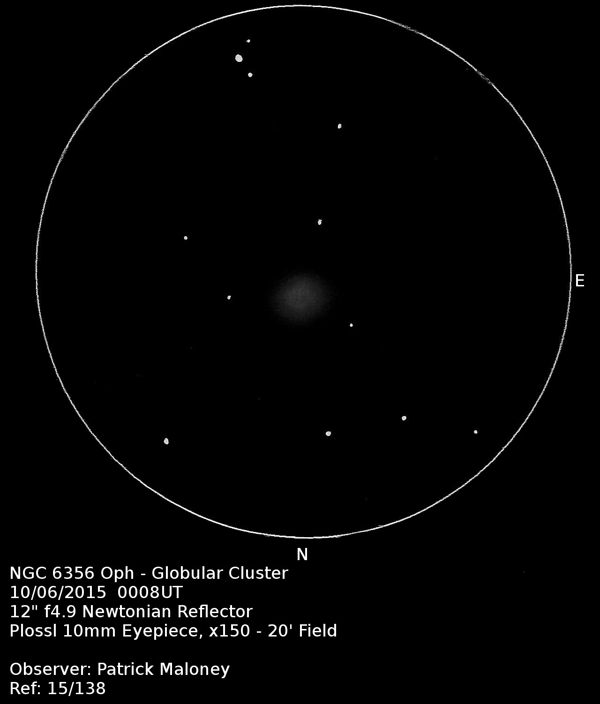NGC 6356 in Ophiuchus
June 2022 - Nebula and Cluster of the Month
June brings the shortest of our nights, but also the promise of better things, as the glorious northern Milky Way comes into prominence in the east, moving to its overhead passage in July. Although the June sky (defined for this column as objects that are at the meridian at midnight at some point during the calendar month) is not as packed as the July sky, there are still some objects worth seeking out.
June is particularly rich in globular clusters, with 30 NGC objects and one IC higher than declination -30° visible at meridian during the month, though it must be confessed that several of these are quite low in British skies.
Our object for this month is one of these globular clusters – not too low, not too high; not too easy, not too difficult. NGC 6356 lies in Ophiuchus, at a declination of close to -18°, and culminates at midnight on the 30th of the month. It is 2.8° south-east of the magnitude 2.5 η Ophiuchi, and 1.2° north-east of Messier 9.

It lies about 50,000 light-years (15,000 pc) away and has a mass of around 600,000 suns. NGC 6356 is a relatively metal-rich globular cluster and was believed for some time to be particularly dust-rich, too. A study published in 1998 by Hopwood, Evans, Penny and Eyres (Mon. Not. R. Astron. Soc. 301, L30-L32 (1998)) determined the quantity of dust in the cluster to be of the order of 0.004–0.017 solar masses, less than was expected for the cluster’s escape velocity, which they quote as 35.6 kms-1.
As with so many of the objects featured in this column, it was first discovered by William Herschel, who spotted it on 17th June 1784. On that occasion, he described it as Bright. Large. Round. Gradually brighter towards the middle. Easily resolvable.
When reading Herschel's descriptions, we need to take two things into account. Firstly, he made most of his observations with an 18” (500mm) reflector, considerably larger than most amateur instruments today, and he did not suffer from light pollution. Both these factors tend to make his descriptions slightly ‘optimistic’ from the point of view of a light-polluted amateur observer of today. However, NGC 6356 is fairly bright, though not very large (depends what you’re comparing it to, I suppose). One thing it certainly isn’t is ‘easily resolved’. The brightest star is magnitude 15.1, making this a tough one to resolve unless you have good skies and a telescope of over 14” (350mm) diameter.
The magnitude quoted for this object in nearly all sources is either 8.2 or 8.4. That does, indeed, make it fairly bright. Even more importantly, it is very concentrated, being classified as a II on the I–XII Shapley-Sawyer concentration scale. This indicates a dense central condensation. For comparison, the bright globular cluster M2 has this same level of concentration.
The diameter of the cluster is usually given as 7.2’, though this takes into account the furthest stragglers. It actually appears considerably smaller than this. Through the eyepiece, expect a diameter of 2’–3’.

I made an observation of NGC 6356 on 10th June 2015 with a 12” Newtonian reflector from my suburban site. I noted that it appeared bright, small and round. I also recorded that I thought I was only seeing the central section (which was true) and that there was no sign of resolution. This is hardly surprising with the brightest stars being 15th magnitude; the faintest stars I recorded on my drawing were between 11th and 12th magnitude.
The resolution of this object is a good test of your conditions and your instrument.
| Object | RA | Dec | Type | Magnitude |
|---|---|---|---|---|
| NGC 6356 | 17h 23’ 35” | -17° 48’ 47” | Globular cluster | 8.2 |